Numerical Investigation of the Influence of Geometric Features and Weld Metal Properties on Stress and Strain States in X80 Girth Welds
Abstract
1. Introduction
2. Materials
2.1. X80 Girth Welding
2.2. Mechanical Properties of the X80 Girth Welds
2.3. Metallographic Characteristics of the X80 Girth Welds
3. Finite Element Analysis Models
3.1. Geometric Parameters
- (1).
- The pipe geometries on both sides of the girth weld were represented as uniform circular shapes with aligned centerlines. Misalignment was characterized by differences in the outer diameters of the pipes, excluding the impacts of axial deviations and pipe ovality variations.
- (2).
- In each girth weld joint model, all geometric features, such as uneven wall thickness, misalignment, transition angles, and weld reinforcement, exhibited total circumferential uniformity.
- (3).
- This study primarily investigated the condition in which the outer diameter of the thicker pipe exceeded that of the thinner pipe. This construction resulted in a root notch formed by the combination of root weld reinforcement and the transition slope of unequal wall thickness, which presented significant geometric discontinuity and represents the highest risk to pipeline safety.
3.2. Material Properties
3.3. Finite Element Modeling
4. Finite Element Analysis Results and Discussion
4.1. Stress and Strain States of the Girth Welds Without Misalignment
4.2. Stress and Strain States of the Girth Welds with 2 mm Misalignment
4.3. Stress and Strain States of the Girth Welds with Internal Pressure
4.3.1. The Influence of Internal Pressure on the Stress States of the Girth Welds
4.3.2. The Influence of Internal Pressure on the Strain States of the Girth Welds
5. Conclusions
- (1)
- Experimental characterization reveals that weld metal strength variations (M = 0.97–1.11) primarily result from differences in Mn and Ni content in the welding materials. These two elements provide significant solid solution strengthening effects and adjust phase transformation temperatures to promote the formation of fine acicular ferrite, improving the microstructure and enhancing the strength of the weld metals.
- (2)
- Finite element analysis indicates that unequal wall thickness critically influences the stress and strain states at the weld root location. Stress triaxiality η and hot spot strain εH increase as the wall thickness ratio increases. In the girth welds with λw = 0.85, M = 0.9, and no misalignment, as t2/t1 increased from 1.0 to 1.4, the increments in η and εH were 0.238 and 1.24%, respectively.
- (3)
- Numerical analysis reveals that misalignment significantly exacerbates the stress and strain states of girth welds. With 2 mm misalignment, η increased by 0.2–0.4, while the increment in εH from t2/t1 variations reached 5.89%, far exceeding the welds without misalignment. The combination of unequal wall thickness and misalignment exacerbates geometric discontinuity, causing severe stress–strain concentration at the weld root.
- (4)
- Weld metal properties significantly affect girth weld stress–strain states. Calculation results indicate that increasing M reduces stress–strain concentration, but its effectiveness diminishes with geometric discontinuity. For m = 0 and t2/t1 = 1.0, raising M from 0.9 to 1.2 reduced η by 0.180; however, for m = 2 mm and t2/t1 = 1.4, the reduction was only 0.097. Higher λw reduces η and increases εH, particularly in undermatched welds with misalignment.
- (5)
- Numerical simulation demonstrates that internal pressure significantly increases stress triaxiality η and hot spot strain εH at the weld root. The effects of t2/t1, m and λw on stress and strain states are more pronounced under internal pressure-loaded conditions. Higher M intensifies the stress triaxiality response to internal pressure while effectively reducing strain concentration sensitivity.
- (6)
- Based on the analysis results, the design of unequal wall thickness girth welds should limit the wall thickness ratio to ≤1.2 with strict misalignment control, employ counterbore-taper design for larger wall thickness ratios, maintain a high strength matching coefficient with adequate toughness, and select weld metals with low yield-to-tensile ratios to mitigate stress and strain concentration.
Author Contributions
Funding
Data Availability Statement
Conflicts of Interest
References
- Tan, Z.; Yang, L.; Zhang, D.; Wang, Z.; Cheng, F.; Zhang, M.; Jin, Y. Development mechanism of internal local corrosion of X80 pipeline steel. J. Mater. Sci. Technol. 2020, 49, 186–201. [Google Scholar] [CrossRef]
- Xia, F.; Li, Z.; Ma, M.; Zhao, Y.; Wu, C.; Su, X.; Peng, H. Effect of Nb on microstructure and corrosion resistance of X80 pipeline steel. Int. J. Press. Vessel. Pip. 2023, 203, 104949. [Google Scholar] [CrossRef]
- Xu, K.; Qiao, G.-y.; Shi, X.-b.; Xiao, F.-r. Effect of stress-relief annealing on the fatigue properties of X80 welded pipes. Mater. Sci. Eng. A 2021, 807, 140854. [Google Scholar] [CrossRef]
- Sharma, S.K.; Maheshwari, S. A review on welding of high strength oil and gas pipeline steels. J. Nat. Gas Sci. Eng. 2017, 38, 203–217. [Google Scholar] [CrossRef]
- Chang, Q.; Cao, Y.; Zhen, Y.; Wu, G.; Li, F. Study on the effect of loading conditions on the fracture behavior of pipeline with girth weld. Int. J. Press. Vessel. Pip. 2023, 203, 104940. [Google Scholar] [CrossRef]
- Cao, Y.; Chang, Q.; Zhen, Y. Numerical simulation of fracture behavior for the pipeline with girth weld under axial load. Eng. Fail. Anal. 2022, 136, 106221. [Google Scholar] [CrossRef]
- Wang, X.; Shuai, J.; Zhang, S.-Z.; Ren, W.; Zhu, X.-M. Numerical study on the strain capacity of girth-welded X80 grade pipes. Pet. Sci. 2022, 19, 2399–2412. [Google Scholar] [CrossRef]
- Sweeney, M.; Gasca, A.H.; Garcia-Lopez, M.; Palmer, A.C. Pipelines and Landslides in Rugged Terrain: A Database, Historic Risks and Pipeline Vulnerability. In Proceedings of the Terrain and Geohazard Challenges Facing Onshore Oil and Gas Pipelines, London, UK, 2–4 June 2004; pp. 641–659. [Google Scholar]
- National Transportation Safety Board. Pipeline Accident Report: Pacific Gas and Electric Company Natural Gas Transmission Pipeline Rupture and Fire; National Transportation Safety Board: San Bruno, CA, USA, 2011.
- Wang, K.; Zhang, M.; Guo, Q.; Ma, W.; Zhang, Y.; Wu, W. Failure Risk Prediction Model for Girth Welds in High-Strength Steel Pipeline Based on Historical Data and Artificial Neural Network. Processes 2023, 11, 2273. [Google Scholar] [CrossRef]
- Jiang, J.; Zhang, H.; Zhang, D.; Ji, B.; Wu, K.; Chen, P.; Sha, S.; Liu, X. Fracture response of mitred X70 pipeline with crack defect in butt weld: Experimental and numerical investigation. Thin-Walled Struct. 2022, 177, 109420. [Google Scholar] [CrossRef]
- Yang, Y.; Zhang, H.; Wu, K.; Chen, P.; Sui, Y.; Yang, D.; Liu, X. Strain capacity analysis of the mismatched welding joint with misalignments of D 1,422 mm X80 steel pipelines: An experimental and numerical investigation. J. Pipeline Sci. Eng. 2021, 1, 212–224. [Google Scholar] [CrossRef]
- Feng, Q.-S.; Zhang, Y.-H. Review and discussion of strength mismatch of girth welds in high strength pipelines. Int. J. Press. Vessel. Pip. 2024, 208, 105118. [Google Scholar] [CrossRef]
- He, W.; Liu, X.; Wang, Q.; Mu, L.; Qin, Z.; Lei, X. Fault Recovery Strategy for Active Distribution Network Considering Repair Sequence Under Extreme Weather. In Proceedings of the 2022 Asian Conference on Frontiers of Power and Energy (ACFPE), Chengdu, China, 21–23 October 2022; pp. 63–69. [Google Scholar]
- Yan, B.-C.; Wang, L.; Wu, G.-Y.; Zhang, Y.-H. Evaluation of strain based ECA method in DNVGL-RP-F108. Int. J. Press. Vessel. Pip. 2023, 202, 104909. [Google Scholar] [CrossRef]
- Pisarski, H.G.; Tkach, Y.; Quintana, M. Evaluation of Weld Metal Strength Mismatch in X100 Pipeline Girth Welds. In Proceedings of the 2004 International Pipeline Conference, Calgary, AL, Canada, 4–8 October 2004; pp. 1589–1596. [Google Scholar]
- Verstraete, M.A.; De Waele, W.; Denys, R.M.; Van Minnebruggen, K.; Hertelé, S. Constraint analysis of defects in strength mismatched girth welds of (pressurized) pipe and Curved Wide Plate tensile test specimens. Eng. Fract. Mech. 2014, 131, 128–141. [Google Scholar] [CrossRef]
- Hochhauser, F.; Ernst, W.; Rauch, R.; Vallant, R.; Enzinger, N. Influence of the Soft Zone on The Strength of Welded Modern Hsla Steels. Weld. World 2012, 56, 77–85. [Google Scholar] [CrossRef]
- Meester, B.d. The Weldability of Modern Structural TMCP Steels. ISIJ Int. 1997, 37, 537–551. [Google Scholar] [CrossRef]
- Hertelé, S.; O’Dowd, N.; Van Minnebruggen, K.; Denys, R.; De Waele, W. Effects of pipe steel heterogeneity on the tensile strain capacity of a flawed pipeline girth weld. Eng. Fract. Mech. 2014, 115, 172–189. [Google Scholar] [CrossRef]
- Wu, K.; Liu, X.; Zhang, H.; Sui, Y.; Zhang, Z.; Yang, D.; Liu, Y. Fracture response of 1422-mm diameter pipe with double-V groove weld joints and circumferential crack in fusion line. Eng. Fail. Anal. 2020, 115, 104641. [Google Scholar] [CrossRef]
- Wang, L.; Tang, Y.; Ma, T.; Zhong, J.; Li, Z.; Zhang, Y.; Xuan, H. Stress concentration analysis of butt welds with variable wall thickness of spanning pipelines caused by additional loads. Int. J. Press. Vessel. Pip. 2020, 182, 104075. [Google Scholar] [CrossRef]
- ASME B31.8 2022; Gas Transmission and Distribution Piping Systems. The American Society of Mechanical Engineers: New York, NY, USA, 2022.
- Sui, Y.; Wang, P. Girth weld welding technology for Heihe-Changling section of The Eastern Natural gas pipeline between China and Russia. Oil Gas Storage Transp. 2020, 39, 961–970. [Google Scholar]
- Pipeline and Hazardous Materials Safety Administration. Pipeline Safety: Girth Weld Quality Issues Due to Improper Transitioning, Misalignment, and Welding Practices of Large Diameter Line Pipe; PHMSA: Washington, DC, USA, 2010.
- Canada Energy Regulator. Girth Weld Area Strain-Induced Failures: Pipeline Design, Construction, and Operation Considerations; CER: Singapore, 2020. [Google Scholar]
- You, X.G.L. Inspection and Disposal of Girth Weld Defects of Oil and Gas Pipelines. Pet. Tubul. Goods. Instrum. 2020, 6, 42–45. [Google Scholar] [CrossRef]
- Sun, P.; Jia, H.; Chen, J.; Li, X.; Han, B. Study on root strain concentration of girth weld joint with variable wall thickness for X80 pipe. Int. J. Press. Vessel. Pip. 2023, 202, 104887. [Google Scholar] [CrossRef]
- Zhang, D.; Liu, X.; Yang, Y.; Chen, P.; Zhang, H.; Hou, X.; Zhang, H. Fracture behavior analysis of X80 pipelines welded joints with unequal wall thickness. J. Constr. Steel Res. 2023, 208, 108000. [Google Scholar] [CrossRef]
- Hu, W.; Gong, B.; Chang, Q.; Zhao, Z.; Dai, L.; Liu, Y. Strain fracture behaviors and crack equivalence of X80 welded joints with non-sharp notches at weld root. Int. J. Press. Vessel. Pip. 2025, 214, 105414. [Google Scholar] [CrossRef]
- Guo, B.; Deng, C.; Wang, Y.; Gong, B.; Ning, J.; Dai, L.; Shen, K.; Zhou, S. Fracture analysis of X80 welded joints with variable wall thickness and misalignment. J. Constr. Steel Res. 2024, 219, 108778. [Google Scholar] [CrossRef]
- Ning, J.; Deng, C.; Dai, L.; Liu, Q.; Gong, B.; Guo, B.; Wang, Y. Fracture behavior analysis of X80 girth welds considering misaligned and variable-wall-thickness geometric features via modified single-edge notched tensile (MSENT) specimens. Eng. Fract. Mech. 2025, 317, 110910. [Google Scholar] [CrossRef]
- Li, Q.; Wang, D.; Deng, C.; Wu, S.; Gao, Z.; Zhao, H.; Liang, H. Role of microstructure heterogeneity on hydrogen-assisted fracture toughness degradation of X80 weld metal in H2S-saturated solution. Corros. Sci. 2023, 224, 111467. [Google Scholar] [CrossRef]
- GB/T 228.1-2021; Metallic Materials—Tensile Testing—Part 1: Method of Test at Room Temperature. Technical Committee 183 on Steel of Standardization Administration of China: Beijing, China, 2021.
- Han, S.Y.; Shin, S.Y.; Seo, C.-H.; Lee, H.; Bae, J.-H.; Kim, K.; Lee, S.; Kim, N.J. Effects of Mo, Cr, and V additions on tensile and Charpy impact properties of API X80 pipeline steels. Metall. Mater. Trans. A 2009, 40, 1851–1862. [Google Scholar] [CrossRef]
- Mohrbacher, H.; Kern, A. Nickel alloying in carbon steel: Fundamentals and applications. Alloys 2023, 2, 1–28. [Google Scholar] [CrossRef]
- Sheykh Jaberi, F.; Kokabi, A.H. Influence of Nickel and Manganese on Microstructure and Mechanical Properties of Shielded Metal Arc-Welded API-X80 Steel. J. Mater. Eng. Perform. 2012, 21, 1447–1454. [Google Scholar] [CrossRef]
- Babu, S.S. The mechanism of acicular ferrite in weld deposits. Curr. Opin. Solid State Mater. Sci. 2004, 8, 267–278. [Google Scholar] [CrossRef]
- Hejazi, D.; Haq, A.J.; Yazdipour, N.; Dunne, D.P.; Calka, A.; Barbaro, F.; Pereloma, E.V. Effect of manganese content and microstructure on the susceptibility of X70 pipeline steel to hydrogen cracking. Mater. Sci. Eng. A 2012, 551, 40–49. [Google Scholar] [CrossRef]
- Bilmes, P.D.; Solari, M.; Llorente, C.L. Characteristics and effects of austenite resulting from tempering of 13Cr–NiMo martensitic steel weld metals. Mater. Charact. 2001, 46, 285–296. [Google Scholar] [CrossRef]
- BS 7910:2019; Guide to Methods for Assessing the Acceptability of Flaws in Metallic Structures. British Standards Institution: Singapore, 2019.
- Wang, Y.-Y.; Liu, M.; Song, Y.; Stephens, M.; Petersen, R.; Gordon, R. Second Generation Models for Strain-Based Design; Pipeline Research Council International: Houston, TX, USA, 2011. [Google Scholar]
- CSA Z662-2007; Oil and Gas Pipeline Systems. Canadian Standards Association: Singapore, 2007.
- Ning, J.; Deng, C.; Wang, Y.; Gong, B.; Guo, B.; Wang, C.; Zhao, N.; Dai, L. Stress state analysis of root notch for X80 girth welds with variable wall thickness and misalignment geometric features. Int. J. Press. Vessel. Pip. 2023, 206, 105064. [Google Scholar] [CrossRef]
- Anderson, T.L. Fracture Mechanics Fundamentals and Applications Fourth Edition; CRC Press: Boca Raton, FL, USA, 2017. [Google Scholar]
- Guo, B.; Zhu, Y.; Dai, L.; Deng, C.; Peng, H.; Wang, D.; Liang, H. Stress state at the root of variable-wall-thickness pipeline welded joint. Int. J. Press. Vessel. Pip. 2022, 200, 104785. [Google Scholar] [CrossRef]

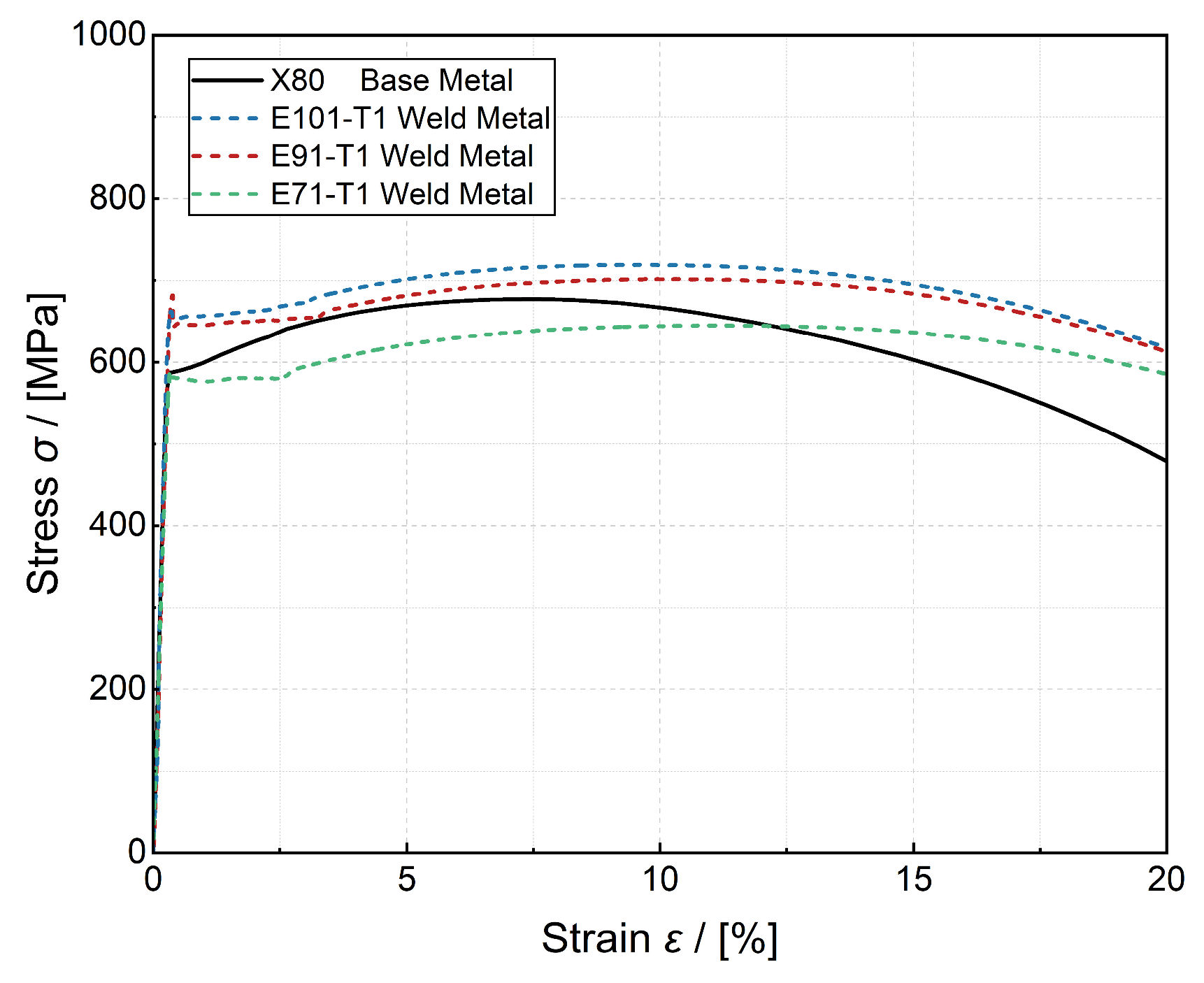

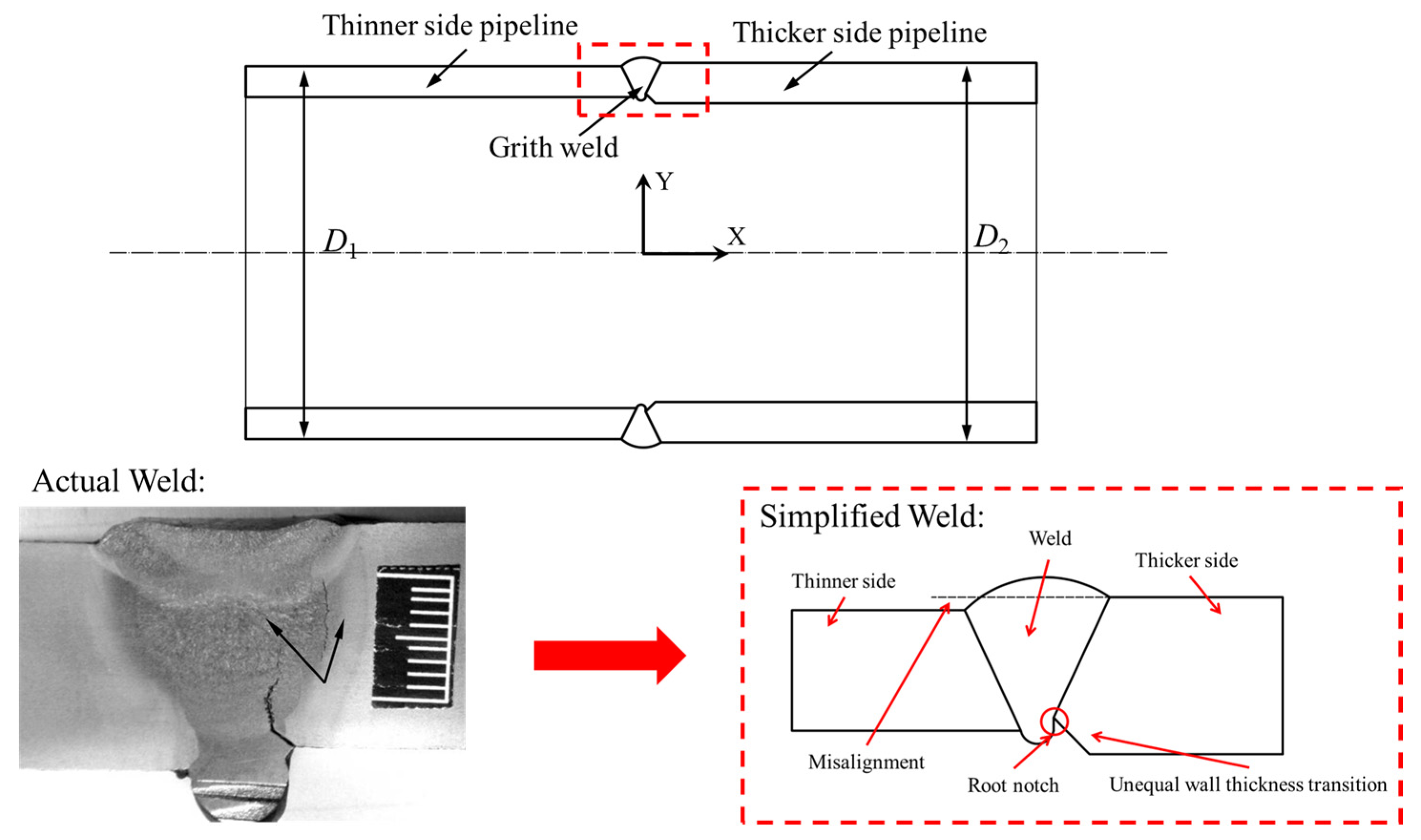


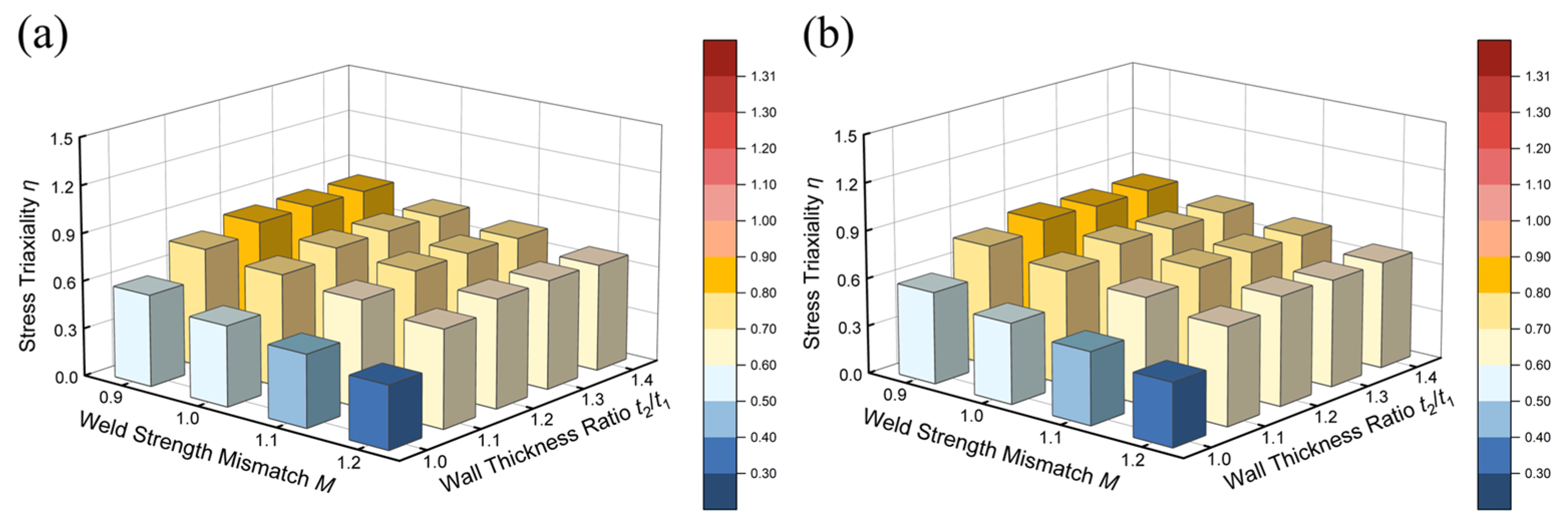

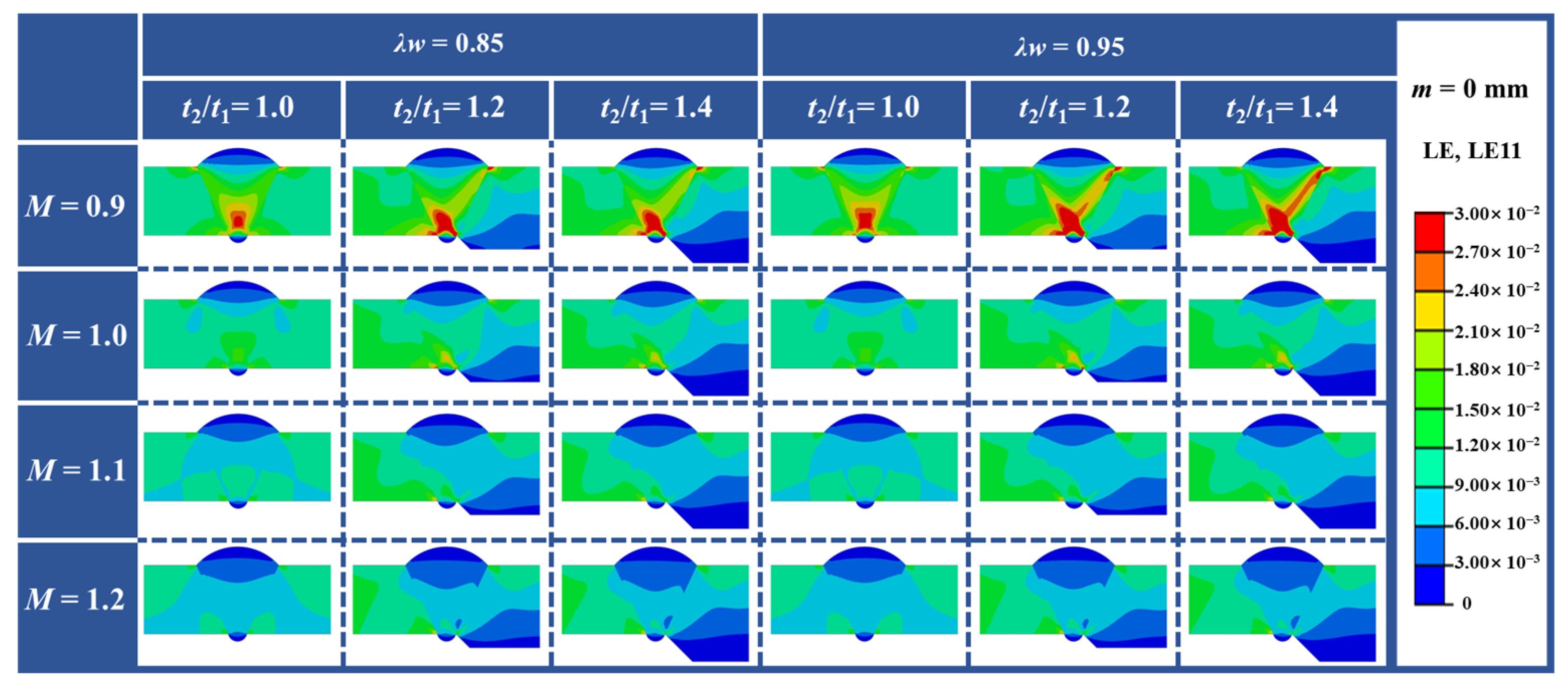
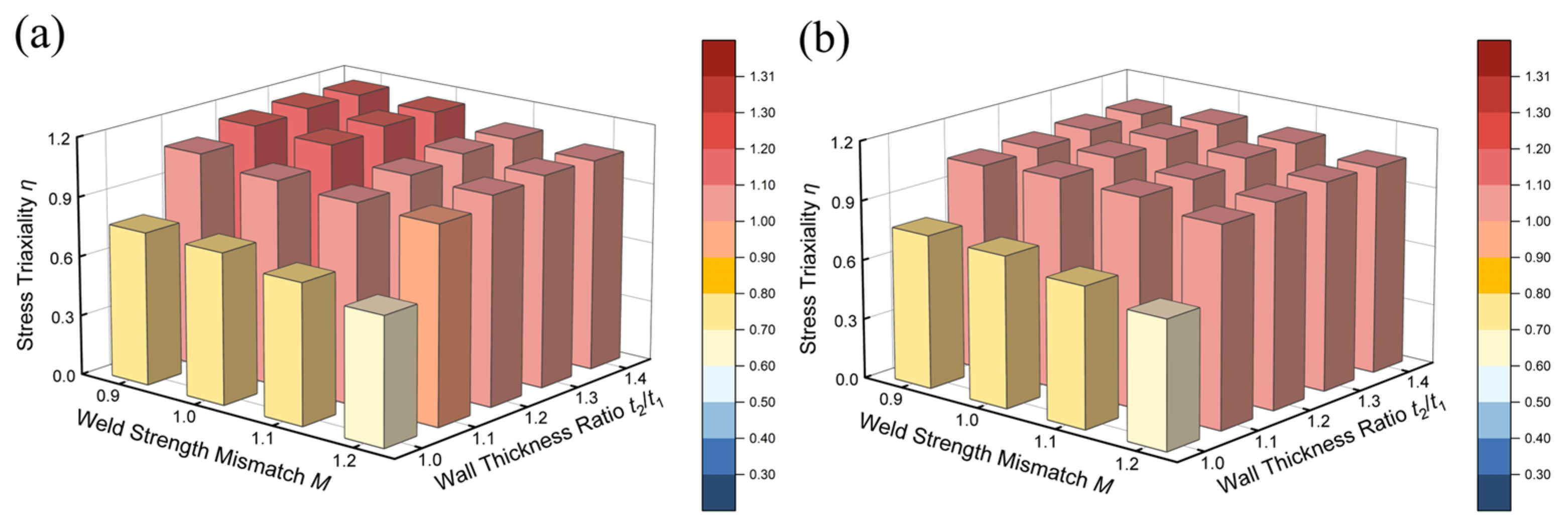
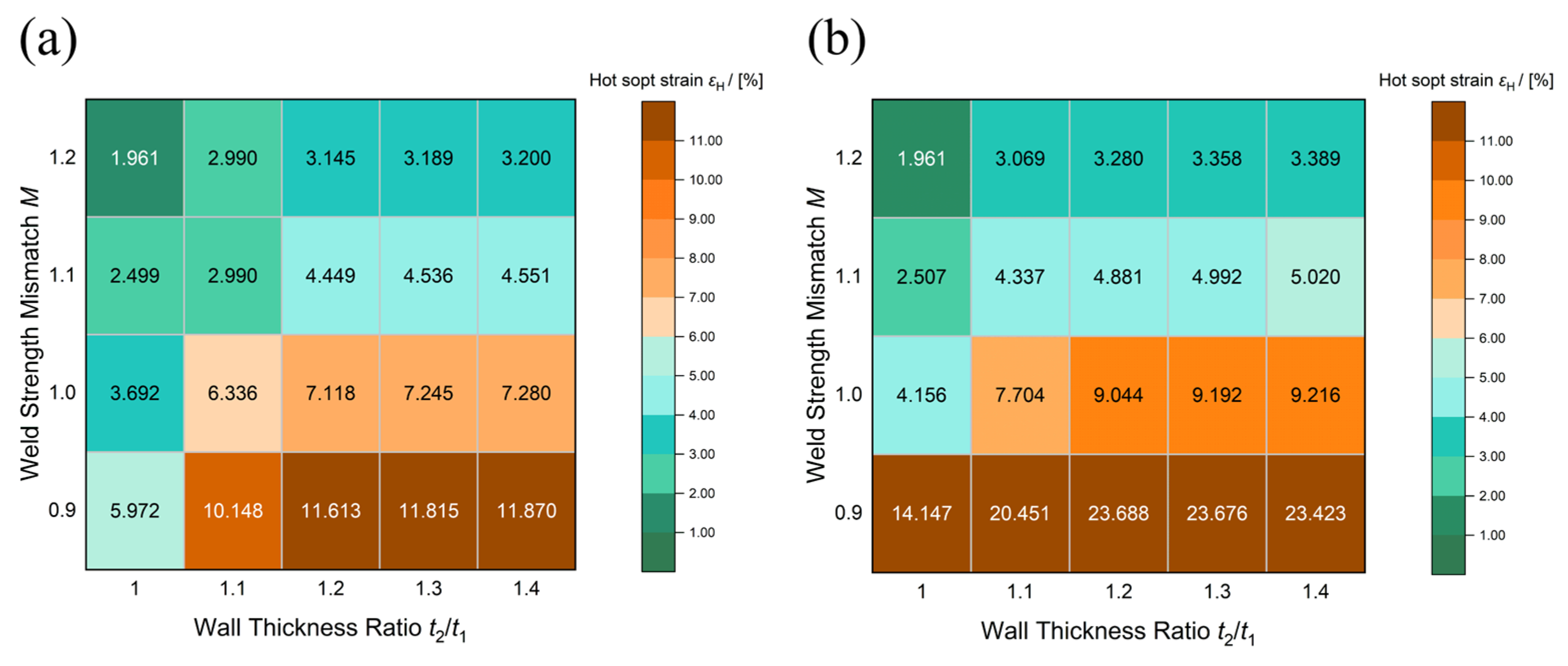
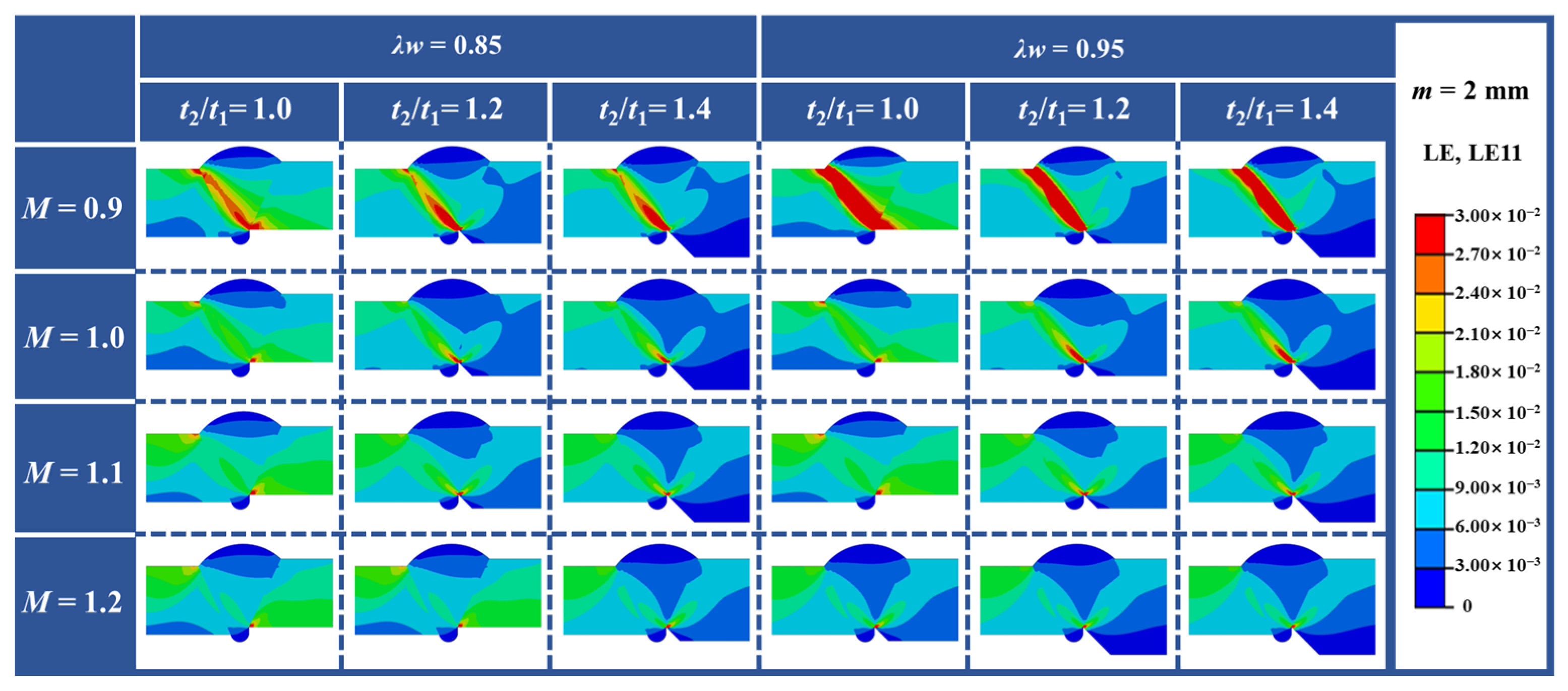
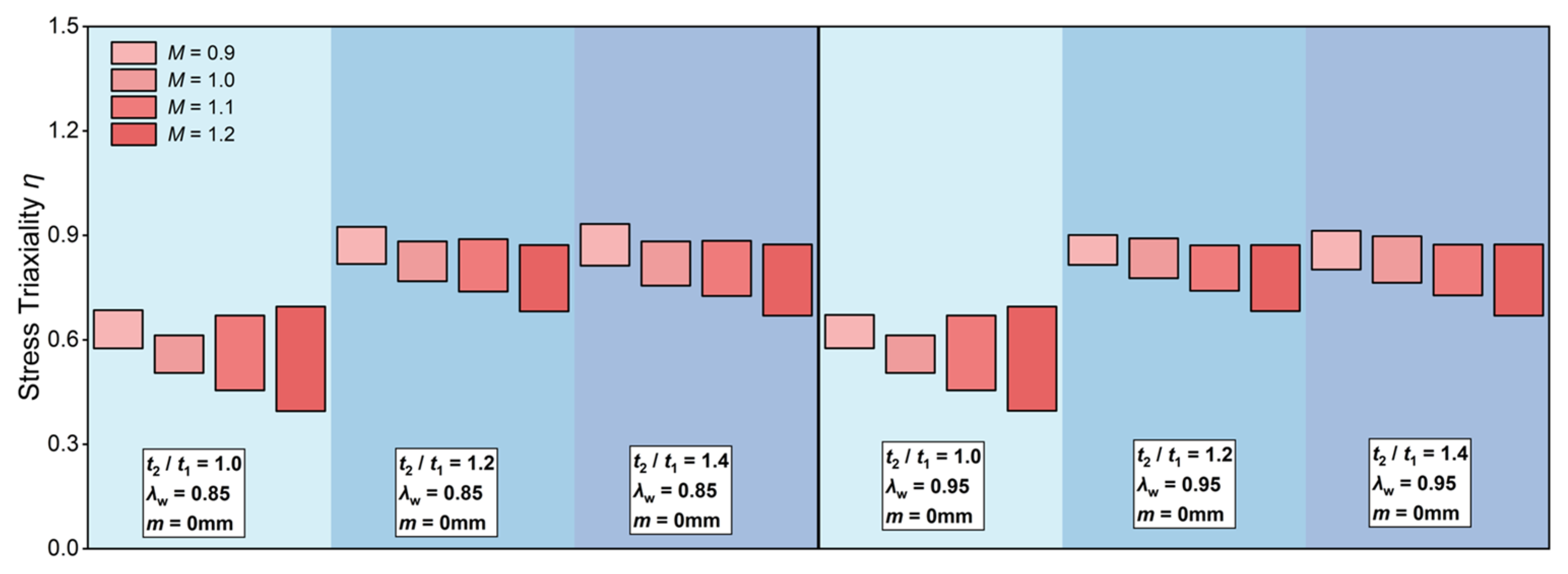

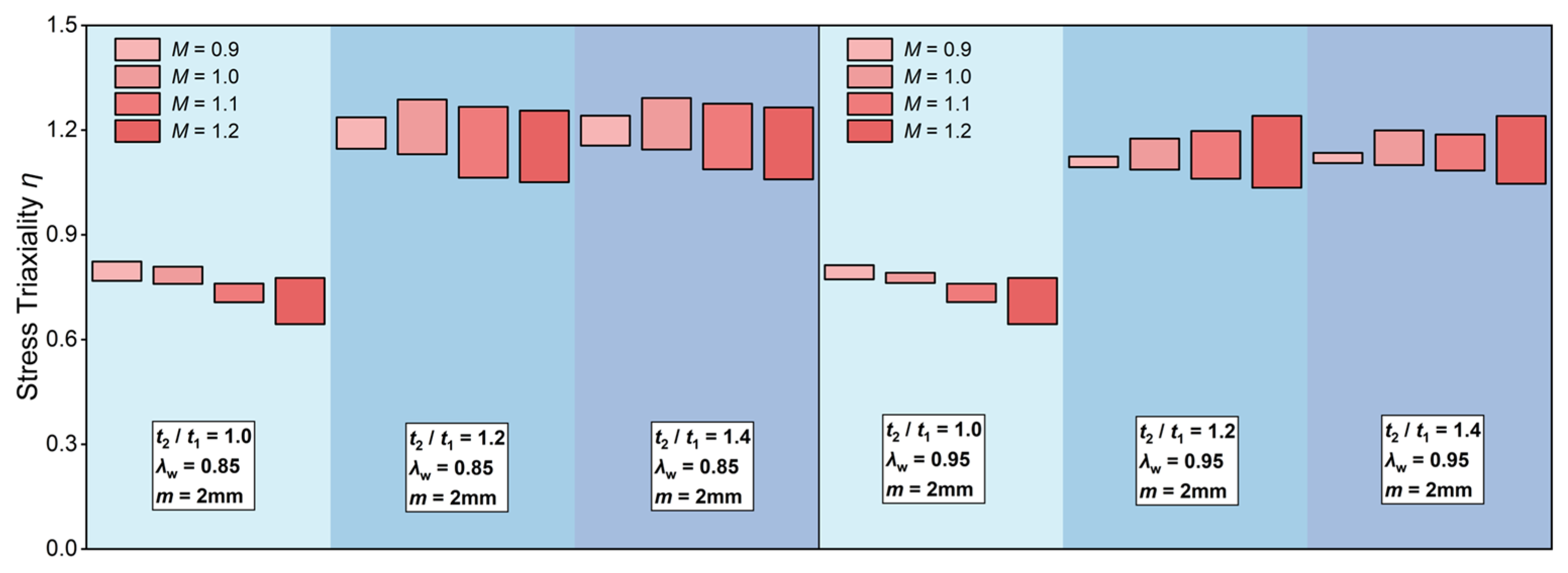

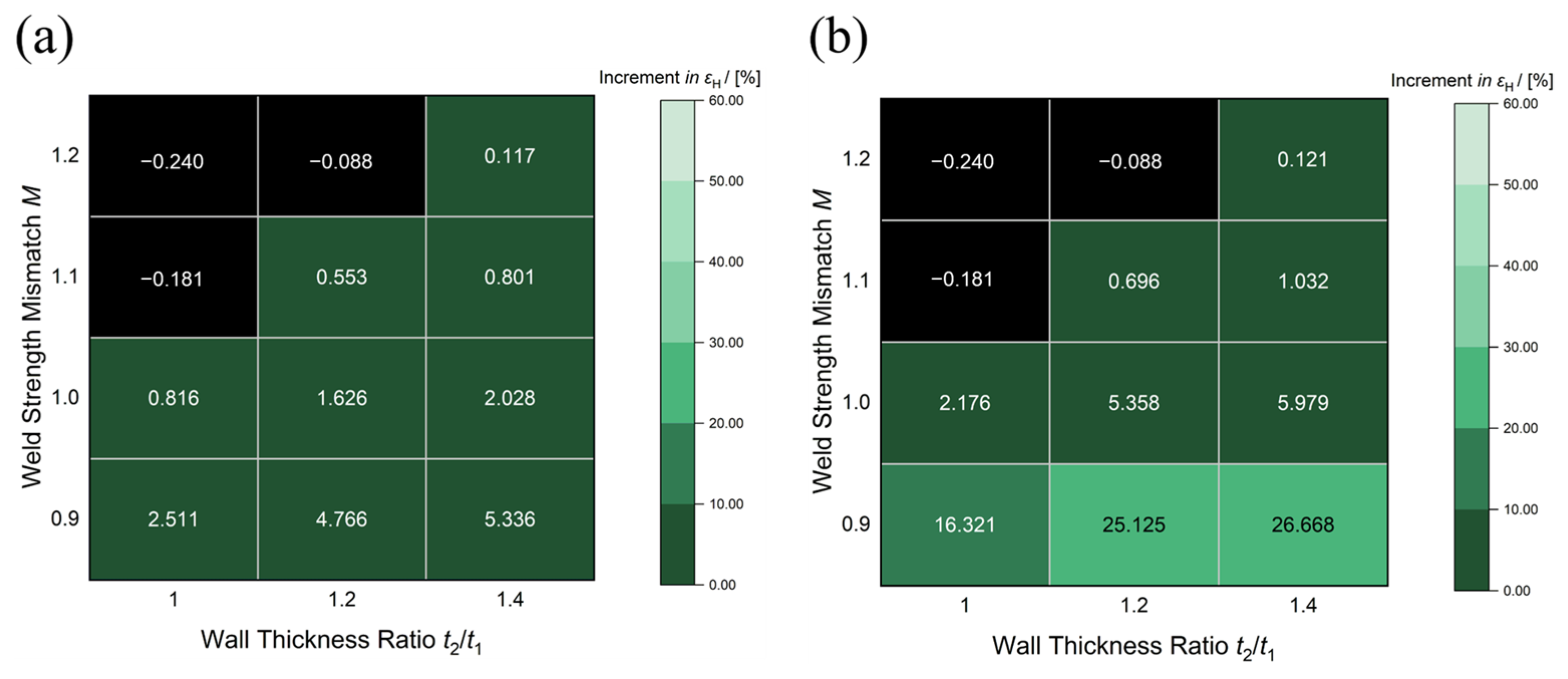

| Materials | C | Mn | Si | Ni | Mo | Fe |
|---|---|---|---|---|---|---|
| X80 Base metal | 0.063 | 1.83 | 0.28 | 0.03 | 0.22 | Bal. |
| Weld material E101T1 | 0.06 | 1.54 | 0.40 | 0.97 | 0.15 | Bal. |
| Weld material E91T1 | 0.05 | 1.25 | 0.37 | 0.93 | 0.12 | Bal. |
| Weld material E71T1 | 0.05 | 1.25 | 0.36 | 0.22 | 0.003 | Bal. |
| Material | Base Metal | Weld Metal E101T1 | Weld Metal E91T1 | Weld Metal E71T1 |
|---|---|---|---|---|
| Yield strength σy/[MPa] | 587 | 657 | 644 | 570 |
| Tensile strength σm/[MPa] | 673 | 719 | 701 | 642 |
| Yield tensile ratio λ | 0.872 | 0.914 | 0.919 | 0.887 |
| Geometric Parameters/Unit | Value |
|---|---|
| Wall thickness of the thinner side t1/[mm] | 18.4 |
| Wall thickness ratio t2/t1 | 1.0, 1.1, 1.2, 1.3, 1.4 |
| Misalignment m/[mm] | 0, 2 |
| Cap weld height h1/[mm] | 5 |
| Root weld height h2/[mm] | 2 |
| Root weld width w/[mm] | 5 |
| Weld groove angle α/[°] | 65 |
| Thickness transition angle γ/[°] | 45 |
| Material Property Parameters/Units | Value |
|---|---|
| Base metal yield strength σyb/[MPa] | 587 |
| Base metal tensile strength σtb/[MPa] | 673 |
| Base metal yield-to-tensile ratio λb | 0.872 |
| Weld strength matching coefficients M | 0.9, 1.0, 1.1, 1.2 |
| Weld metal yield strength σyw/[MPa] | 528.3, 587, 645.7, 704.4 |
| Weld metal yield-to-tensile ratio λw | 0.85, 0.95 |
| Parameters/Unit | Value |
|---|---|
| Wall thickness ratio t2/t1 | 1.0, 1.1, 1.2, 1.3, 1.4 |
| Misalignment m/[mm] | 0, 2 |
| Weld strength matching coefficients M | 0.9, 1.0, 1.1, 1.2 |
| Weld metal yield-to-tensile ratio λw | 0.85, 0.95 |
Disclaimer/Publisher’s Note: The statements, opinions and data contained in all publications are solely those of the individual author(s) and contributor(s) and not of MDPI and/or the editor(s). MDPI and/or the editor(s) disclaim responsibility for any injury to people or property resulting from any ideas, methods, instructions or products referred to in the content. |
© 2025 by the authors. Licensee MDPI, Basel, Switzerland. This article is an open access article distributed under the terms and conditions of the Creative Commons Attribution (CC BY) license (https://creativecommons.org/licenses/by/4.0/).
Share and Cite
Guo, B.; Deng, C.; Gong, B.; Liu, Y.; Ning, J.; Zhang, K. Numerical Investigation of the Influence of Geometric Features and Weld Metal Properties on Stress and Strain States in X80 Girth Welds. Metals 2025, 15, 986. https://doi.org/10.3390/met15090986
Guo B, Deng C, Gong B, Liu Y, Ning J, Zhang K. Numerical Investigation of the Influence of Geometric Features and Weld Metal Properties on Stress and Strain States in X80 Girth Welds. Metals. 2025; 15(9):986. https://doi.org/10.3390/met15090986
Chicago/Turabian StyleGuo, Baichen, Caiyan Deng, Baoming Gong, Yong Liu, Jiaao Ning, and Ke Zhang. 2025. "Numerical Investigation of the Influence of Geometric Features and Weld Metal Properties on Stress and Strain States in X80 Girth Welds" Metals 15, no. 9: 986. https://doi.org/10.3390/met15090986
APA StyleGuo, B., Deng, C., Gong, B., Liu, Y., Ning, J., & Zhang, K. (2025). Numerical Investigation of the Influence of Geometric Features and Weld Metal Properties on Stress and Strain States in X80 Girth Welds. Metals, 15(9), 986. https://doi.org/10.3390/met15090986





